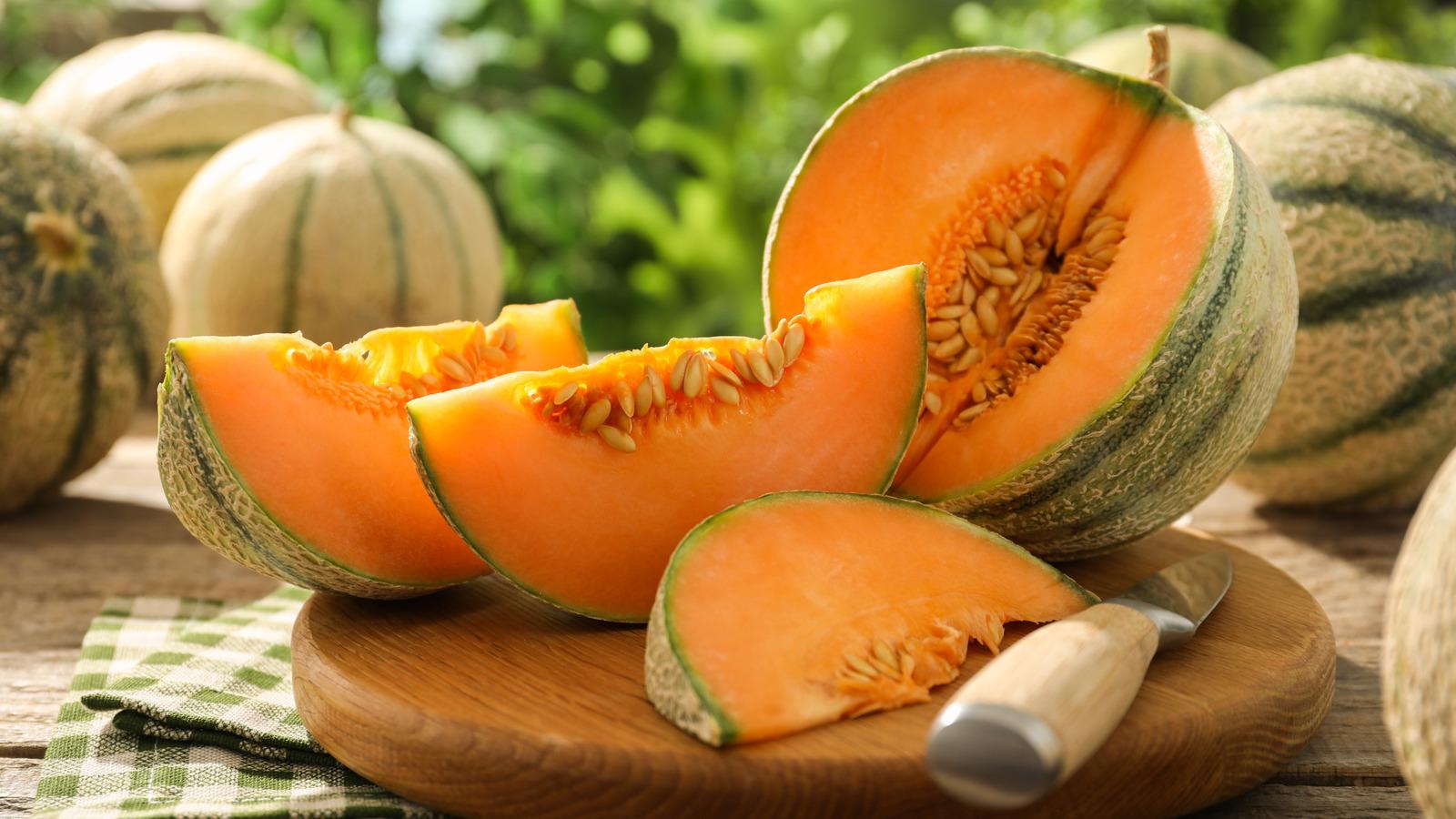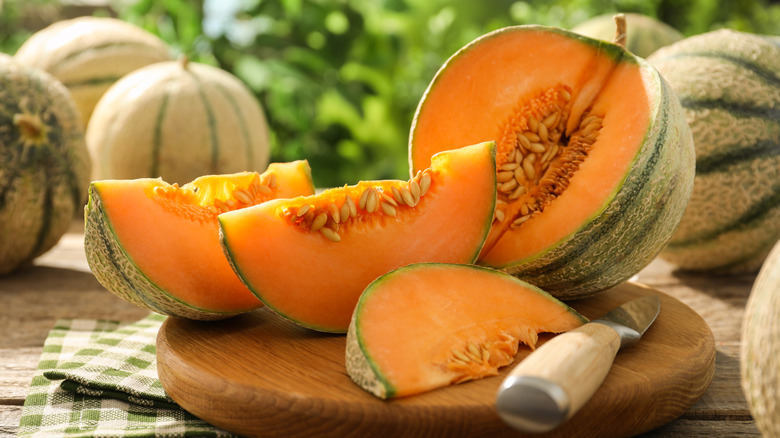
Olga Yastremska/Getty Images
There's nothing quite like biting into a perfectly ripe cantaloupe. That sweet, juicy, almost floral flavor is where it's at. But we've all been there: standing in the produce aisle, staring at a mountain of melons, and wondering if we're about to bring home a good one or one that would have been best left at the store. That's why there are mistakes to avoid when picking cantaloupe.
Finding the freshest produce can feel like a total gamble. I know I've picked my fair share of duds, only to get home and realize I've made a crucial error in judgment. But as a food writer and recipe developer, food is my raison d'être, so over the years I've done my research and learned the telltale signs of a melon that's ripe but not past its best.
Picking a great cantaloupe isn't some mystical art form reserved for melon farmers or professional chefs. It's a skill you can totally master with a few simple tips and tricks. Once you've learned the ways, you'll never have to suffer through another bland breakfast or disappointing fruit salad. We're going to walk through the most common mistakes people make when buying cantaloupe, so you can confidently grab the best of the bunch every single time.
1. Ignoring the scent
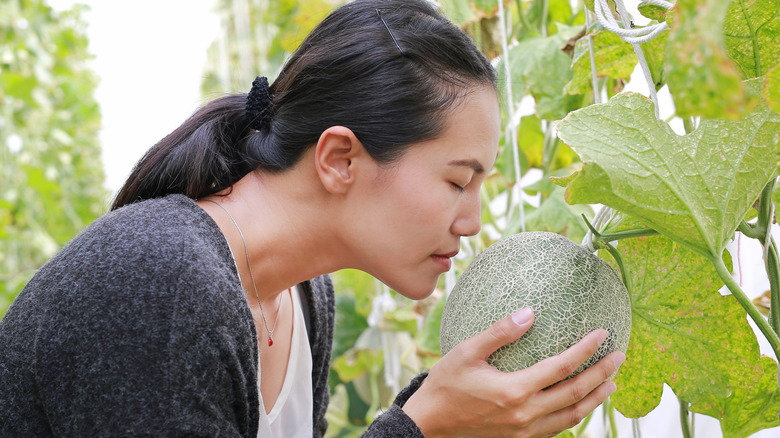
GOLFX/Shutterstock
You might feel a little silly standing in the middle of the produce aisle, picking up a cantaloupe, bringing it right up to your nose, and breathing in deep. But it's one of the most important steps you can take. It's the best quick test for judging a ripe cantaloupe. Ignoring the aroma is like trying to pick a great scented candle without smelling it first. A truly ripe and ready-to-eat cantaloupe will have a wonderfully fragrant, sweet, and slightly musky aroma. It's a sign that the sugars inside the melon have fully developed, promising big flavor when you finally cut it open at home.
So, how do you do it right? Pick up the melon and give it a good sniff at the blossom end, the circular, rough spot on the opposite side of where the stem was attached. If it smells sweet and basically like how you imagine good cantaloupe smelling, you're on the right track. If you get your nose right up to it and smell absolutely nothing, put it back. A scentless cantaloupe is unripe, and it's not going to magically develop more flavor on your kitchen counter. On the flip side, be wary of a smell that's overly strong, fermented, or alcoholic. That's a sign the melon is past its prime and has started to spoil. Trust your senses on this one, they'll never steer you wrong.
2. Choosing a cantaloupe with squishy areas
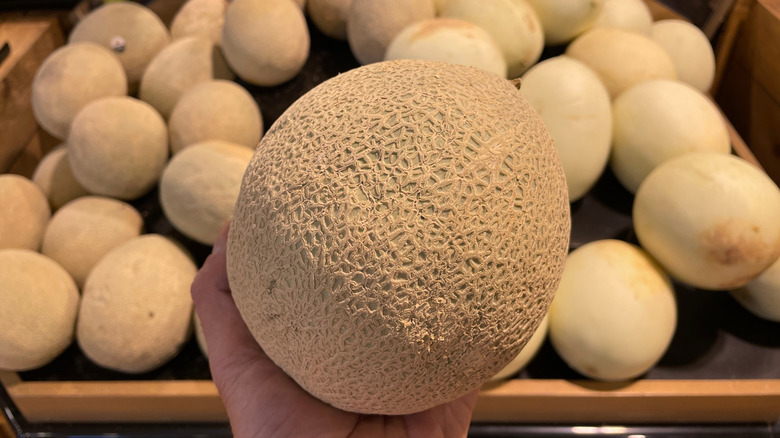
Billy F Blume Jr/Shutterstock
This one might seem like a no-brainer, but in the rush of grocery shopping, it's surprisingly easy to pick up a cantaloupe with squishy areas. You spot a melon that looks good from one angle, toss it in your cart, and don't discover the sad, mushy spot on the other side until you get home.
A squishy or bruised area is a major red flag. It's one of the easiest ways to tell if your cantaloupe has gone bad. These soft spots are a clear indication that the fruit is either overripe, has been damaged from being dropped, or is beginning to rot. When the flesh becomes mushy, it means the cell walls have started to break down, which results in that slimy, stringy texture that nobody enjoys.
To avoid this fate, make sure you give your potential cantaloupe a gentle but thorough all-over inspection. Run your hands over the entire surface, applying light pressure. What you're looking for is a consistent firmness. The melon should feel solid and sturdy from end to end. Any area that feels noticeably soft, wet, or gives way easily under your thumb should be considered a deal-breaker. The only exception to this rule is the blossom end, which should have a very slight give when you press on it. That's actually a sign of ripeness. But any other squishy spot is a sign to move on and find a better, firmer candidate for your fruit salad.
3. Taking home a cantaloupe that's light for its size
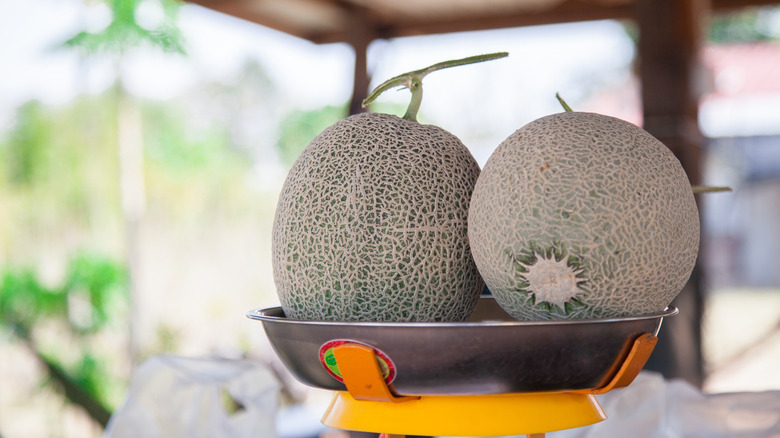
Nitiphonphat/Shutterstock
The weight of your cantaloupe matters more than you might imagine. A fantastic, juicy specimen is full of water, which is what makes it so refreshing. And all that water content makes it heavy. If you pick up a melon and it feels surprisingly light for its size, you're likely holding a dud. A lightweight cantaloupe is a sign that it's either underripe and hasn't had the chance to develop its juicy flesh, or it's old and has started to dry out from the inside. Either way, it's not going to be a good example of the fruit.
The best way to use this trick is to do a little comparison shopping. Don't just grab the first one that looks good. Instead, pick up two or three cantaloupes that are roughly the same size. Hold one in each hand and feel the difference. You're looking for the one that feels the most substantial and dense for its dimensions. It should feel heavier than you expect it to. This simple heft test is an easy way to weed out subpar melons and ensure you go home with a winner.
4. Not shaking it
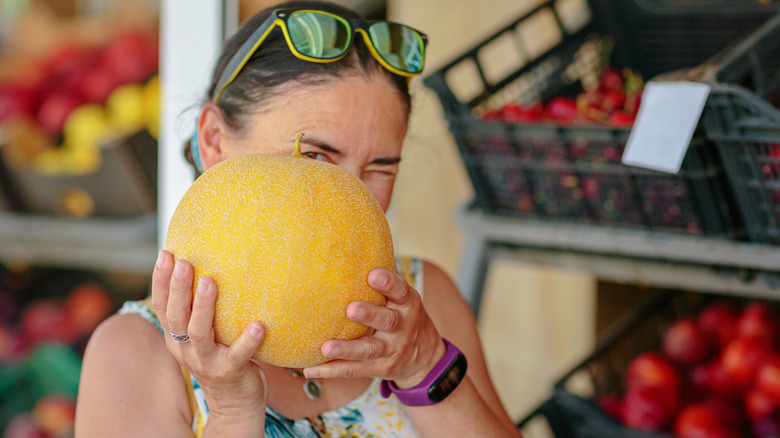
Svittlana/Shutterstock
It might feel a bit strange picking up a melon and shaking it in the produce aisle, like you're playing the maracas. However, it's one of the lesser-known ways to pick a good cantaloupe, so avoiding shaking it for fear of looking silly is a total mistake. Gently shake the fruit next to your ear. If you hear a soft rattling sound, it means the seed cavity has detached from the flesh of the fruit, which is an indication that it's overripe.
Overripe cantaloupe can be mushy or mealy, rather than the soft but slightly crisp texture that's ideal. And, while a slightly overripe melon might be edible (but not the most delicious), that can soon change. If you're not eating it right away, even a slightly-past-its-best fruit can turn rotten and inedible within a couple of days.
It's a great way of spotting an overripe melon before it's got to the point of any visible signs of decay. Yes, it's a bit unorthodox, but what does it matter being that supermarket kook who sniffs and shakes melons when you take home the perfect one? You end up with the last laugh compared to those people who've picked up a mealy cantaloupe.
5. Selecting a cantaloupe with cuts or cracks
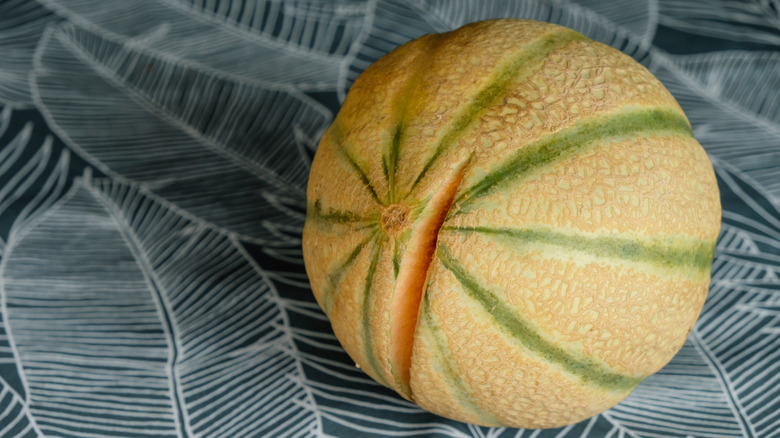
Ganna Zelinska/Getty Images
A cantaloupe's rind is a natural shield protecting the flesh inside. When you're at the market, give each cantaloupe a good once-over. You're looking for a smooth, unblemished surface. Any cantaloupe with visible cracks, cuts, or holes is a no-go. These imperfections aren't just cosmetic. They provide a route for bacteria and mold to sneak inside. A small crack can quickly become a host for decay, and you'll end up with a mealy, overripe, or moldy melon.
Even if the crack looks tiny, it's best to move on. That little blemish could indicate that the fruit was dropped or improperly handled during transit, and its interior might be damaged as well. And this isn't a risk you want to take when you likely have a whole bin full of cantaloupes to choose from.
A healthy cantaloupe has a robust, intact rind. It's not necessarily a standalone sign that you've got a ripe fruit on your hands, but the lack of cuts and cracks at least shows you that there's no obvious damage. So, take your time, inspect each one, and only choose the cantaloupes that look perfect on the outside. Use this in conjunction with other tests like smell and weight and you should take some a perfect cantaloupe.
6. Picking a cantaloupe that's too hard or too soft
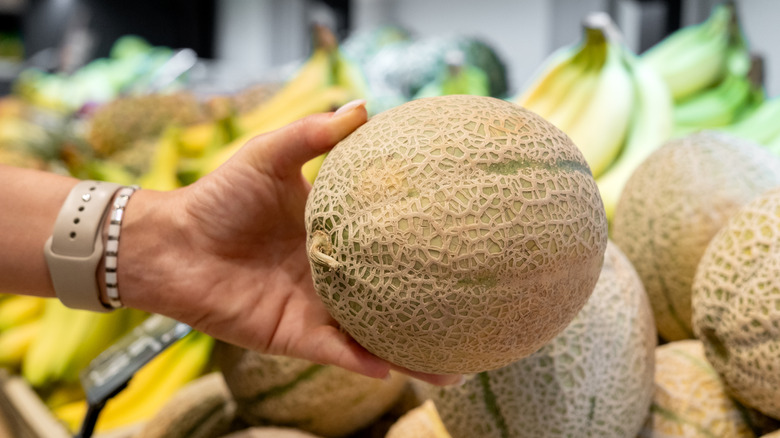
Elena Noviello/Getty Images
The Goldilocks rule applies to cantaloupes: you want one that's not too hard and not too soft, but just right. First, gently press the blossom end. It should give slightly under the pressure of your thumb, but not feel mushy. Then give the rest of the melon a slight squeeze — you don't want to go around bruising every one you touch so use some restraint. It should feel firm but not hard.
A cantaloupe that feels overly soft or spongy to the touch is probably past its prime. This indicates that the flesh has begun to break down. The melon may have a mealy or slimy texture and a fermented, unpleasant taste. But if it's rock-hard, it's underripe and won't have developed its full sweetness. A melon that's too firm is best left on the shelf to ripen another day.
A slight give without being soft is a sign of ripeness, showing that the fruit is at the peak of its flavor and ready to be enjoyed. It can take a bit of time to really get a feel for it, so it's good to start by pairing it with other tests of ripeness, like smell and appearance. However, once you get your head around it, a quick squeeze of a cantaloupe can tell you what you need to know.
7. Buying a cantaloupe that's too smooth
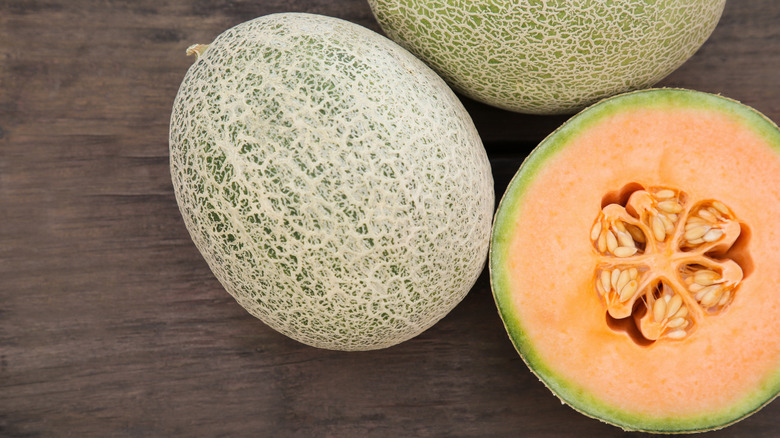
Liudmila Chernetska/Getty Images
Cantaloupe is a kind of muskmelon, a variety that's known for its raised netting on the outside. So, choosing a specimen that's too smooth is actually a bad thing. Don't be fooled by a smooth cantaloupe thinking it's better than the ones covered in webbing. You're actually looking for a little texture. Specifically, the distinctive raised netting that covers the rind. This develops as the fruit ripens, so when it's missing, it almost certainly wasn't left on the vine for long enough.
The webbing should feel rough and raised to the touch. If a cantaloupe's surface feels too slick or smooth, it's a bad thing. This can mean the melon was picked before it had a chance to fully ripen and develop its characteristic texture. The best cantaloupes have a full web-like pattern that stands out and covers the entire fruit. It's a direct result of the melon's natural ripening process. So next time you're at the market, run your hand over the cantaloupes. Choose the one that feels rough and bumpy, not smooth. It might look like scarring, but it's just how a cantaloupe is naturally. The absence of it means a melon isn't ready yet.
8. Choosing a green cantaloupe
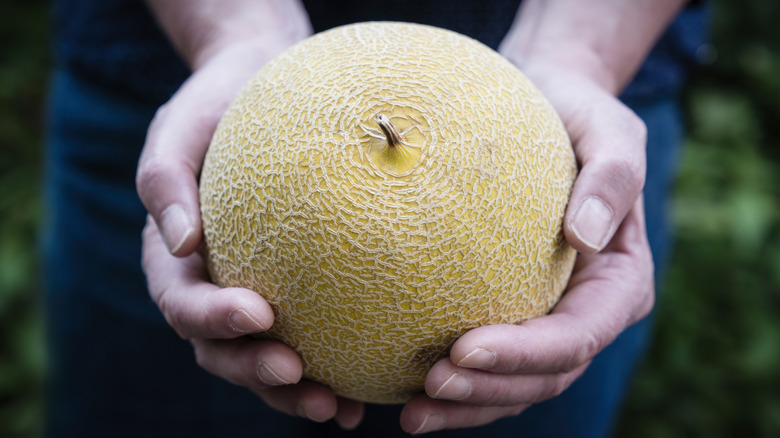
Tina Terras & Michael Walter/Getty Images
A perfectly ripe cantaloupe should have a creamy, beige, golden-yellow, or pale orange background color, not a green one. The netting or webbing might be what you think of first when you picture a cantaloupe, but it's the color underneath that tells the real story. As a melon ripens, its skin transitions from a dull green to a yellow-orange hue — though the exact shade varies depending on the variety of the cantaloupe.
This color change indicates that the fruit's natural sugars have fully developed. A melon with a dominant green hue is still underripe. It hasn't had the chance to soak up all the sun it needs to reach its peak sweetness, and it will likely be flavorless and crunchy. That said, some cantaloupes have natural green stripes, which can be confusing. If the rest of the melon is a tan, yellow, or pale orange and the stripes alone are green, they're likely meant to be this way.
That perfect color is the melon's way of showing you it's ready. The color should be consistent across the entire melon, with no large patches of green, except for on striped varieties. While a small amount of green near the stem end is common, the overall color should lean heavily toward the yellow-orange side. Don't grab a cantaloupe that's green, even if it passes other tests like feeling firm, but not too firm, with a good netting built up. Trust the color, and you'll be well on your way to picking a cantaloupe that's ready to deliver on flavor.
9. Selecting a cantaloupe with the vine still attached
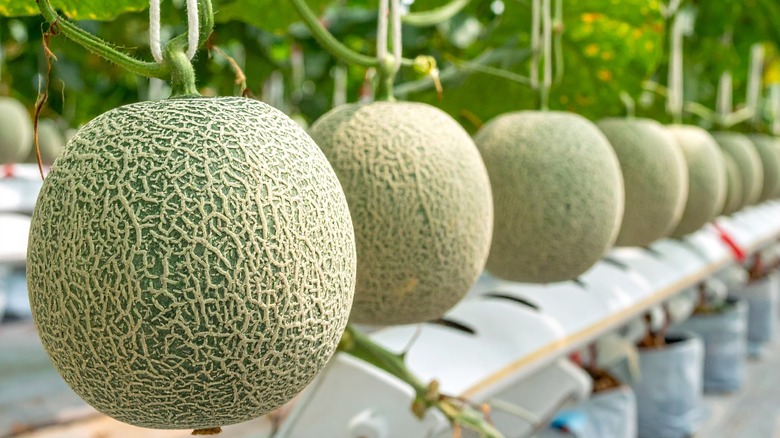
TernakGajah/Shutterstock
You might not think much about the little indent where the cantaloupe's stem used to be, but it's actually a reliable sign of ripeness. A ripe cantaloupe will have a kind of belly button where the stem was once attached. This clean, concave circle indicates that the melon naturally separated from its vine when it was fully mature. This process, known as a "full slip," is the plant's way of telling you the fruit is at its peak of flavor and sweetness.
On the other hand, a cantaloupe that still has part of its stem attached, or has a jagged, torn-looking stem end, is a sign that it was likely picked prematurely. This happens when a melon is pulled from the vine before it's ready to detach on its own. A melon that was picked too early won't ripen properly at home.
There are fruits that continue to ripen when picked, but cantaloupe isn't one of them. Once it's been harvested, it won't get significantly sweeter or juicier. So, if it's picked before its time, it won't ever be perfectly ripe. It will just go from underripe to rotten over time. Therefore, when you see a cantaloupe with the vine still attached, you know it's not going to be a great one.
10. Buying it out of season
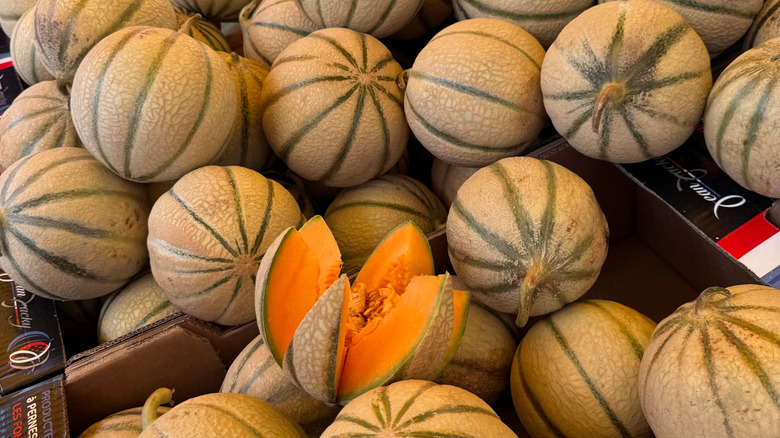
blondewayfarer/Shutterstock
What you should know before buying cantaloupe is that it's not in season all year round even though it's always in stores. If you want a truly spectacular cantaloupe, timing is everything. Just like tomatoes in the summer and pumpkins in the fall, cantaloupes have a prime season, and that's when you'll find them at their most flavorful. The sweet spot for cantaloupe is generally from June to October. During this period, the melons are grown and harvested under ideal conditions, meaning they get all the sunshine they need to develop well.
For the absolute best cantaloupe experience, skip the big grocery stores and head to a farmers' market or a local farm stand. Produce at these places is often picked at the peak of ripeness and sold to you within a day or two. This makes all the difference. Unlike melons shipped across the country, which may be picked early to survive transit, a local cantaloupe is picked at its best. This makes a monumental difference in taste. Buying in season from a local source will give you the best fruits and means you're supporting local farmers, too.
11. Not giving it a tap
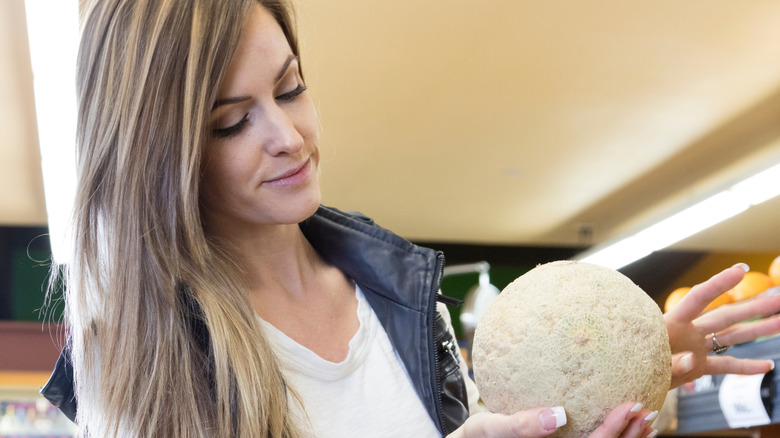
Bill Oxford/Getty Images
Whether you're making a fruit salad or eating it straight up, you want your cantaloupe to be just right. One of the mistakes people make in the store is not giving it a tap. You've probably seen savvy home cooks do this before, and for good reason. Tapping a melon is a tried-and-true way to gauge its ripeness.
Hold the cantaloupe in one hand and give it a firm, but gentle, tap. The sound you're listening for is a deep, hollow, and resonant thump. That low sound indicates that the melon is full of juice and perfectly ripe. It means the flesh inside is firm and ready to eat, not dried out or mushy.
If you tap the melon and it produces a high-pitched, tight, or flat sound, it's a sign that the fruit is underripe and still dense inside. It hasn't developed the liquid content that gives it that satisfying thump. Conversely, a dull, dead thud can mean the melon is overripe, with the internal structure beginning to break down. Combine this with other signs like smell, color, and weight and you're basically guaranteed to take home a perfectly ripe cantaloupe.



